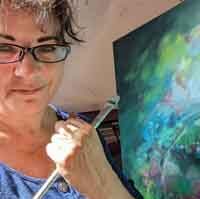No products in the cart.

As a child, I taught myself to draw and paint by copying pictures from wildlife and horse books on an
almost daily basis and the skills I acquired were added to throughout school and art college.
However, my first real introduction to life as a working artist began on leaving art college when I discovered that the Brighton art galleries and the local job center did not, at once, sign me up for a glittering career as an artist. In the job center, when I informed my consultant that I had a Fine Arts degree, the lady laughed sympathetically and then offered me a job as a chambermaid (which I
took). In the art galleries I visited, I was told I needed to be an ‘emerging’ or ‘mid-career’ artist in order for
them to be interested. I tried to convince them I had, in fact, ‘emerged’ at age 3 but my reasoning failed to impress and so like millions before me I discovered the well-known issue of needing to be ‘a name’ before I was ‘a name’.
However, regardless of not winning the Turner Prize or being Picasso, I continued to draw and to paint and regularly took part in or organized exhibitions where I sold work or was given commissions.

I am a professional artist based in East Sussex who creates large semi-abstract landscapes, seascapes, and wildlife paintings in oil on canvas. My painting style is very distinct and fuses art-nouveau, impressionist, and semi-abstract techniques with traditional portraiture that reflects my love of nature, animals, birds, and the flora and fauna of the landscapes around me. My main working method has been the development of a painting style I term ‘memory impressionism’. This method involves going walking somewhere, looking at and absorbing the things I see and experience, and then returning home to my studio to try and capture an echo or essence of the place from memory –
including any wildlife I may have seen. By this method, I can capture the essences and echoes of places and the feeling I have about them. I love the ancient landscapes of England and my paintings often reflect the spiritual elements that such landscapes have.

In the 1990s I met an art agent who traveled the area selling animal portrait commissions and I became one of the artists he represented which was an excellent experience as it demanded I learn some formal portrait painting techniques. Commissions continued as my main income source until around 2010 when I first began to sell art online. The success I had on this allowed me to spend more time developing new ideas and techniques and, for the first time in my career, I painted for my own pleasure, eventually developing a distinctive style of my own. I am a self-representing artist and although I am happy to work with galleries and agents occasionally, I prefer to remain in control of my own creativity.

